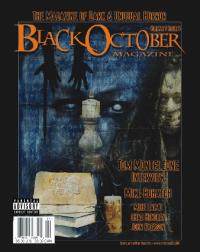"Bloodwork" by Eric Scott
Sleepwalker (novel excerpt) by Michael Laimo
"The Beginning was the End" by John Everson
"The Haunting of Lew Salmonson" by Bill Mingin
"In All This" by Jack Fisher
"Darke Traffick" by David Hollier
"Play Things" by R.H. Stavis
"In Sheep's Clothing" by Chris Roberson
"The Wreck of the Il Virgo Idolin" by Lou Kemp
"A Certain Doorway" by Keri Knutson
 The first story up in issue six of Black October: The Magazine of Dark and Unusual Horror is Eric Scott's "Bloodwork." In it, the protagonist meets Caspian, a renegade demon, at a Goth club and tags along as the demon commits a number of evil deeds. The protagonist's true nature is revealed at the end, which is a bit of a twist, but it's not really a grabber. The biggest drawback in this story was Caspian's dialogue, which read like a mishmash of every "evil for evil's sake" type of villain from time immemorial.
The first story up in issue six of Black October: The Magazine of Dark and Unusual Horror is Eric Scott's "Bloodwork." In it, the protagonist meets Caspian, a renegade demon, at a Goth club and tags along as the demon commits a number of evil deeds. The protagonist's true nature is revealed at the end, which is a bit of a twist, but it's not really a grabber. The biggest drawback in this story was Caspian's dialogue, which read like a mishmash of every "evil for evil's sake" type of villain from time immemorial.
Next up is an excerpt from Michael Laimo's novel, Sleepwalker, which is interesting enough, but too brief to give the reader a feel for what the book is about. Another demon turns up in John Everson's, "The Beginning Was the End." This particular fallen angel is engaged in an illicit affair with an angel that eventually goes…well…to hell.
In "The Haunting of Lew Salmonson," by Bill Mingin, a man pleads with his neighbor, who just happens to be a psychic investigator, to contact his late wife, who died by her own hand. A well-written piece, but neither the reason for the wife dying nor the eventual outcome came as much of a surprise.
Jack Fisher, presumably the same Jack Fisher who edits Flesh and Blood magazine, contributes "In All This," a tale as unsettling as it is brief. "Darke Traffick," by David Hollier, has something to do with light-sensitive ghouls in a castle and their efforts to destroy the sun, but, in spite of a few good passages, the piece feels unfocused and doesn't seem to go anywhere.
Trying to write a suitably scary yarn about a malevolent toy is quite a feat and one that not many have been able to pull offsome that come to mind are William Goldman's Magic and perhaps the first Chucky movie. R. H. Stavis does a decent job with "Play Things," a tale of a jack-in-the-box tormenting and dispatching young children. The prose is awkward in places, but the description of the creature is certainly a high point.
Chris Roberson's "In Sheep's Clothing" attempts to squeeze a little more juice out of the tried and true werewolf sub-genre, but the piece, which is literally all talk and no action, turns out to be not much more than a cautionary tale about mistreating others because they're different.
"The Wreck of the Il Virgo Idolin," by Lou Kemp, is one of the more effective tales in this issue. It tells of a young woman at sea, traveling to be married. As the other passengersincluding her fiancébegin to die off, Helen realizes the captain's true intentions. Well done throughout, but it's Kemp's short and not-so-sweet ending that makes this tale.
Rumors of the ghost story's demise have been greatly exaggerated, as Keri Knutson proves in this issue's last storywhich is arguably the best in show. "A Certain Doorway" is an eerie, understated yarn set in an old mansion, in which many of the rooms have been sealed off. A young woman, her brother, and their spinster aunt inhabit the house. As the tale unfolds, it becomes apparent that the latter two are not particularly concerned over what may be residing in the mansion's empty rooms.
In addition to the nine fiction selections in this issue, there is also nonfiction in the form of an interview with Tom Monteleone; G. W. Thomas's essay on William Hope Hodgson's ghost hunter, Carnacki; and a history of absinthe, by Dale Walter. Other features include illustrations by Mike Bohatch and four selections from featured poet, Chad Hensley. Not a bad trick, squeezing this much content into a nicely produced 54-page magazine.